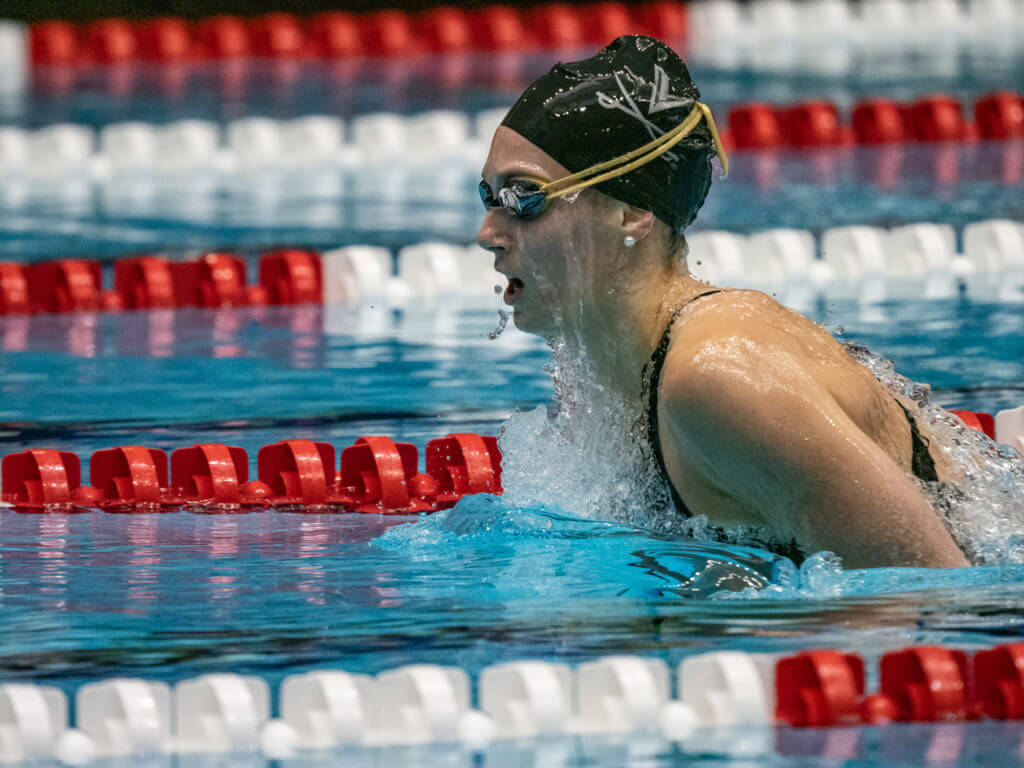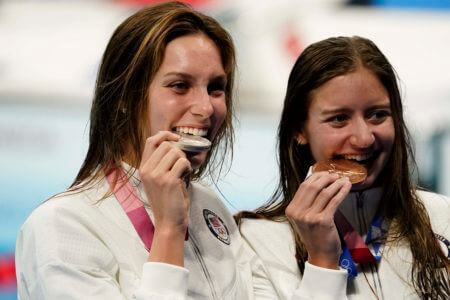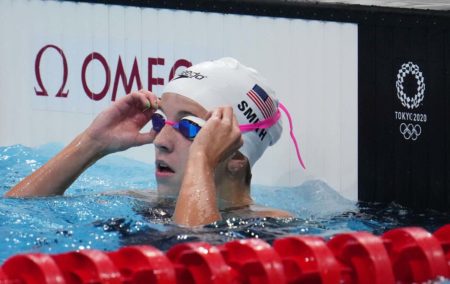Virginia vs. Stanford: New Rivalry in Women’s College Swimming Taking Shape

Virginia vs. Stanford: New Rivalry in Women’s College Swimming Taking Shape
These days, the University of Virginia is the trendy team in women’s college swimming. The Cavaliers had a very real shot at capturing a national title in 2020 prior to the cancellation of the NCAA championships due to the COVID-19 pandemic. But coach Todd DeSorbo’s group just had to wait another year for their coronation, and in 2021, Virginia dominated the championships, the margin of victory a whopping 139 points.
Meanwhile, the team that had won the three previous national titles, Stanford, ended up ninth, the Cardinal’s roster depleted of much of the incredible talent that had launched its dynasty of 2017, 2018 and 2019. The teams led by Katie Ledecky, Simone Manuel and Ella Eastin in 2017 and 2018 were untouchable, and group featuring less depth but still led by Eastin and Taylor Ruck in 2019 extended that streak. Heck, the year before Stanford’s run of titles, head coach Greg Meehan’s group came within one disqualified relay of a national title, even with Manuel taking an Olympic redshirt and Ledecky deferring her enrollment for a year.
But for the 2021-22 season, Stanford will be back. The team has added three Olympic veterans, all of whom swam in at least one individual Olympic final in Tokyo and all of whom brought home at least a relay medal. Meanwhile, Virginia has said good-bye to Paige Madden but returns its two other Olympic medalists while adding a third Tokyo podium finisher and one of the top young sprinters in the country.
Any doubts on which teams will be locked in battle for the NCAA team title when the teams get together for this year’s championships in mid-March in Atlanta?
That’s just this year. Then, for the 2022-23 school year, Stanford will bring in Claire Curzan, another Olympian and one of the best high school short course swimmers ever. Stakes raised.

The Virginia duo of Alex Walsh (left) and Kate Douglass went 2-3 in the 200 IM at the Tokyo Olympics — Photo Courtesy: Rob Schumacher/USA TODAY Sports
Looking at this year’s showdown, the Cavaliers return Alex Walsh, last year’s 200 IM champion and the Olympic silver medalist in the long course version of the event. Ditto Kate Douglass, who won the 50 free and finished second in two other events before joining Walsh on the podium for the 200-meter IM in Tokyo with a bronze in the 200-meter IM in Tokyo. Also back are two-time NCAA runner-up Ella Nelson and A-finalists Lexi Cuomo, Reilly Tiltmann, Alexis Wenger and Abby Harter.
The additions include 400-meter IM Olympic silver medalist Emma Weyant and sprinter Gretchen Walsh, younger sister of Alex and the national high-school-record holder in the 50 and 100 free. Virginia has already started the season quickly with both Douglass and Gretchen Walsh splitting 20.9 on relays at the Cavaliers’ intrasquad meet.
Who could challenge that group? A team featuring superstar freshmen Regan Smith and Torri Huske and a returning Ruck, now a two-time Olympian and a finalist in the 200 back in Tokyo. At her only prior NCAAs, Ruck took second in the 200 free and 200 back and third in the 100 back.
Smith won three medals in Tokyo, bronze in the 100 back, silver in the 200 fly and silver in the 400 medley relay. In short course yards, Smith holds the American records in both backstroke events and ranks second all-time in the 200 fly. She would be heavily favored to win all three of those events at the NCAA championships, even with the 200 back-200 fly double on the meet’s final day.
Huske, meanwhile, was fourth in the 100-meter fly in Tokyo, but her path to an NCAA title in that event goes through Maggie MacNeil, the fastest swimmer of all-time in the event and the Olympic gold medalist in the meters race from Tokyo, and Douglass. Huske has the advantage of being able to swim just about any race she wants really well, so Meehan has some options when deciding how to maximize her point totals given all the extraordinary talent at his disposal.

Three-time Olympic medalist Regan Smith will make her long-awaited Stanford debut this season — Photo Courtesy: Robert Hanashiro/USA Today Sports
Relay-wise, Ruck, Smith and Huske will all contribute majorly to Stanford’s relays, only one of which finished above eighth last year. Will they bring enough to beat out Virginia’s deep sprint squads? Right now, the edge still belongs to the returning champs.
Maybe Virginia does have enough to hold on and defend that national crown. Maybe the Olympians will push Stanford back to the top of the pile. Regardless, this season will build-up toward that clash of elite programs led by elite coaches. The always-exciting NCAA championships could get a superstar-driven team battle for the ages. Excited yet, swim fans?
And then, as the following season approaches, Curzan will arrive on the Farm. The 17-year-old from Cary, N.C., made her long-awaited college decision this week. Curzan qualified for the Olympic team after finishing second to Huske in the 100 fly at Olympic Trials, but before that, she was simply magnificent all spring as she inched close to short course records and turned herself into a bona fide Olympic contender in multiple events.
Curzan plus Smith, Huske and, for one year, Ruck? That has the look of a super-team. Can you imagine those medley relays if only Stanford can find the right breaststroker to handle that leg? Maybe Stanford can convince current senior Allie Raab to stick around for a fifth year.
No doubt, Curzan’s commitment shifts the balance of power in women’s college swimming back westward to the Cardinal. Can Virginia land the counterpunch and pose a legitimate challenge? The Cavaliers have a solid recruiting class of their own, although no swimmers on Curzan’s level.
We’ll find out. This is the new signature rivalry in women’s college swimming, two schools separated by an entire country and almost 3000 miles. Stanford is primed to rebound after a one-year drop-off, so this year’s NCAAs should be chapter one.




I believe that Taylor Ruck was only at Stanford one year. She took 2 Olympic Redshirt years. As such, I believe she has 3 years of eligibility left (including this year), not two.